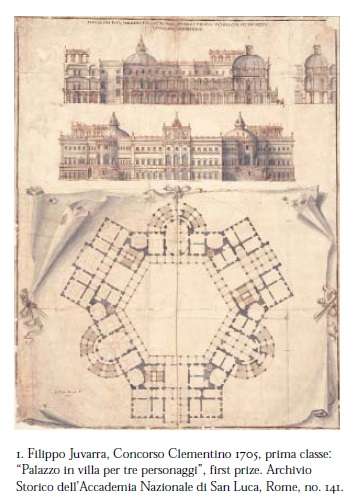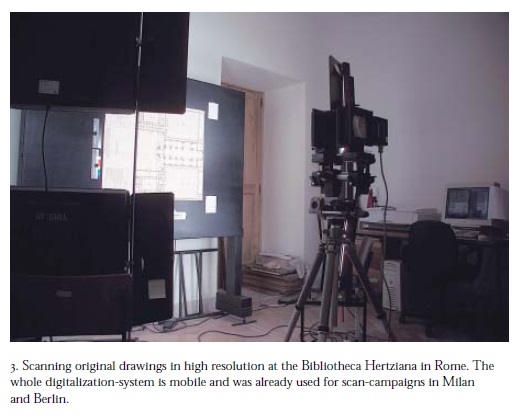Serviços Personalizados
Journal
Artigo
Indicadores
-
 Citado por SciELO
Citado por SciELO -
 Acessos
Acessos
Links relacionados
-
 Similares em
SciELO
Similares em
SciELO
Compartilhar
Anales del Instituto de Investigaciones Estéticas
versão impressa ISSN 0185-1276
An. Inst. Investig. Estét vol.26 no.85 Ciudad de México Set. 2004
Obras, documentos, noticias
Lineamenta. An Online-Database for the Study of Architectural Drawings
Elisabeth Kieven
Scholarly interest in architectural drawings has in recent times considerably broadened its prospects. Architectural drawings are no longer considered uniquely as sources of information referring directly to specific buildings or to project processes, but are rather studied as autonomous artistic products and as a mean of communication between architect and patron.
With the objective of scholarly surveying Italian architectural drawings from the 17th and 18th centuries, the Bibliotheca Hertziana (Rome) —Max Planck Institute for Art History is setting up a database for research purposes that can be entirely managed and consulted online. The database aims at offering more than conventional catalogues of collections, digital or non-digital, inasmuch as the data on the drawings will be connected with information on individuals and institutions, buildings, projects, archive sources and bibliography. High resolution scanning of the drawings and specific tools for the analysis of images on the computer screen offers new prospects for the study of architectural drawings. The database has the goal of virtually bringing together drawings at present scattered in collections throughout the world; its structure allows research on a complex level and also offers a new, differentiated approach to existing documentary material. The focus is on architectural and art history phenomena such as the creation of architectural drawing collections in the 18th century, the spreading in Europe of individual drawings and buildings utilized as models in academic teaching and in the architectural practice, artistic and professional exchange between architects and patrons, and the development of technical and formal traditions.

The link between data referring to the drawings and an interactive catalogue of plans of Rome, also in the course being set up at the Bibliotheca Hertziana, will widen the perspective to an overall urban dimension. The outcome of the entire operation will also include the tracing of a new global overview that could determine new scholarly relevant issues.
The setting up of the database, carried out through the cooperation with international institutions and agencies, originated from the first surveys and scanning campaigns of the data from the drawing collection of the Accademia di San Luca in Rome and from the Kunstbibliothek in Berlin. The gathering and analyzing of the extensive material regarding the Trevi Fountain in Rome is scheduled as part of ECHO, an interdisciplinary project financed by the European Union (European Cultural Heritage Online, http://echo.mpiwg-berlin.mpg.de/home). The contribution of other important collections of architectural drawings like the collection from the Archivio del Moderno in Mendrisio (Switzerland) and the Graphische Sammlung (Staatliche Museen Kassel, Germany) to Lineamenta started recently and agreements with further institutions are under way.
From a technical standpoint Lineamenta will be supported by a XML diagram (ZUCCARO, "ZOPE-based Universally Configurable Classes for Academic Research Online"), utilizing PostegreSQL for the storage of data and complex research. One of the main objectives in the development of ZUCCARO is the possibility of obtaining user interfaces and thesauri in different languages. Owing to its modular structure and reconfiguration possibilities, this open source system can be easily adapted to the demands of other databases intended for studies in the humanities: the XML diagram guarantees data exchange among different installations. ZUCCARO constitutes the basis for the cooperation between the two data base projects of the Bibliotheca Hertziana, Lineamenta and ArsRoma (painting in Rome 1580-1630).

The specific graphic server DIGILIB allows online access to high resolution scanning of drawings (files up to 400MB in size) without the installation of other programs, so that drawings can actually be studied and analyzed on the computer screen. For the collection of the Accademia di San Luca in Rome the full scans are accessible without any password. It is possible to make measurements utilizing historic units of measure (ARCHIMEDES), to confront different images, comment on the drawings or their details, and send notes by e-mail. The viewing of the plate in its original dimensions and other similar tools allow the correct evaluation of the drawing's level of precision and quality of execution even on the computer screen. The Bibliotheca Hertziana is one of the first art history institutes qualified to digitize architectural drawings up to dimension of an Ao sheet with such high resolution as to render the entire density of information of the original, down to the structure of the paper. Lineamenta thus facilitates access to the drawings while contributing to the preservation of their delicate original material.















